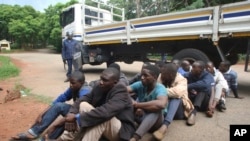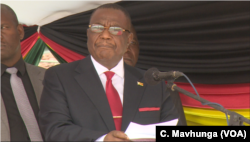The Zimbabwean government's crackdown on fuel hike protesters has seen at least 12 people killed and more than 300 wounded in clashes with security forces, and as many as 600 people arrested.
On Tuesday, President Emmerson Mnangagwa called for an investigation into the violence, but analysts charge his new government planned the unrest.
VOA spoke to witnesses who gave some graphic and upsetting accounts of events. The stories are chilling.
For the past two weeks, amid an intermittent internet blackout, witnesses say Zimbabwean security forces have been rampaging through the population, in what analysts say is a planned, coordinated attempt to quash dissent.
"We had people who were shot at point blank, almost one meter away, two meters away, straight into the head, which means the intention was actually to kill. It wasn't non-intentional. … And this one is also another case of a deceased person, who was actually shot point blank in Chitungwiza, into the head, he had brains all over," recalls Dr. Norman Matara, a general practitioner who left Zimbabwe last week. In Johannesburg, he showed journalists graphic photographs of the casualties, some with horrific bruises and gunshot wounds.
Matara's organization, the Zimbabwe Association of Doctors for Human Rights, said they are certain the recent violence is orchestrated.
Southern Africa researcher Dewa Mavhinga of Human Rights Watch (HRW) said the violence is unquestionably tied to President Mnangagwa.
He was elected on July 30 amid promises to set a new course after years of repression under longtime leader Robert Mugabe. Those promises fell flat just two days later, when soldiers shot dead six protesters on the streets of the capital.
Since Mnangagwa announced a 150 percent increase in fuel prices in early January, which sparked protests, the violence has mounted -- and been shockingly brazen, HRW's Mavhinga said.
"During Mugabe's time, I think there was an attempt to sort of mask and hide these things and give more of a front," Mavhinga said. "But these guys, in uniform, in broad daylight, you saw on the first of August, we saw it just in this last week, so the militarization is now more open. The disregard for the law is now more open."
What no one knows is why this is happening, analyst Piers Pigou of the International Crisis Group said.
The most popular theory is that there is a power struggle between the president and his deputy, General Constantino Chiwenga, who was the muscle behind the November 2017 push that forced Mugabe to resign.
"The question in my mind is, to what end? What on Earth is the purpose of this? Because it seems to be, in many ways, an exercise in self-destruction in terms of undermining their own reform and re-engagement strategy," Pigou said.
As analysts debate the causes, the violence continues. Pigou pointed to his phone, saying while he was being interviewed even more details of violence and arrests were being reported.












